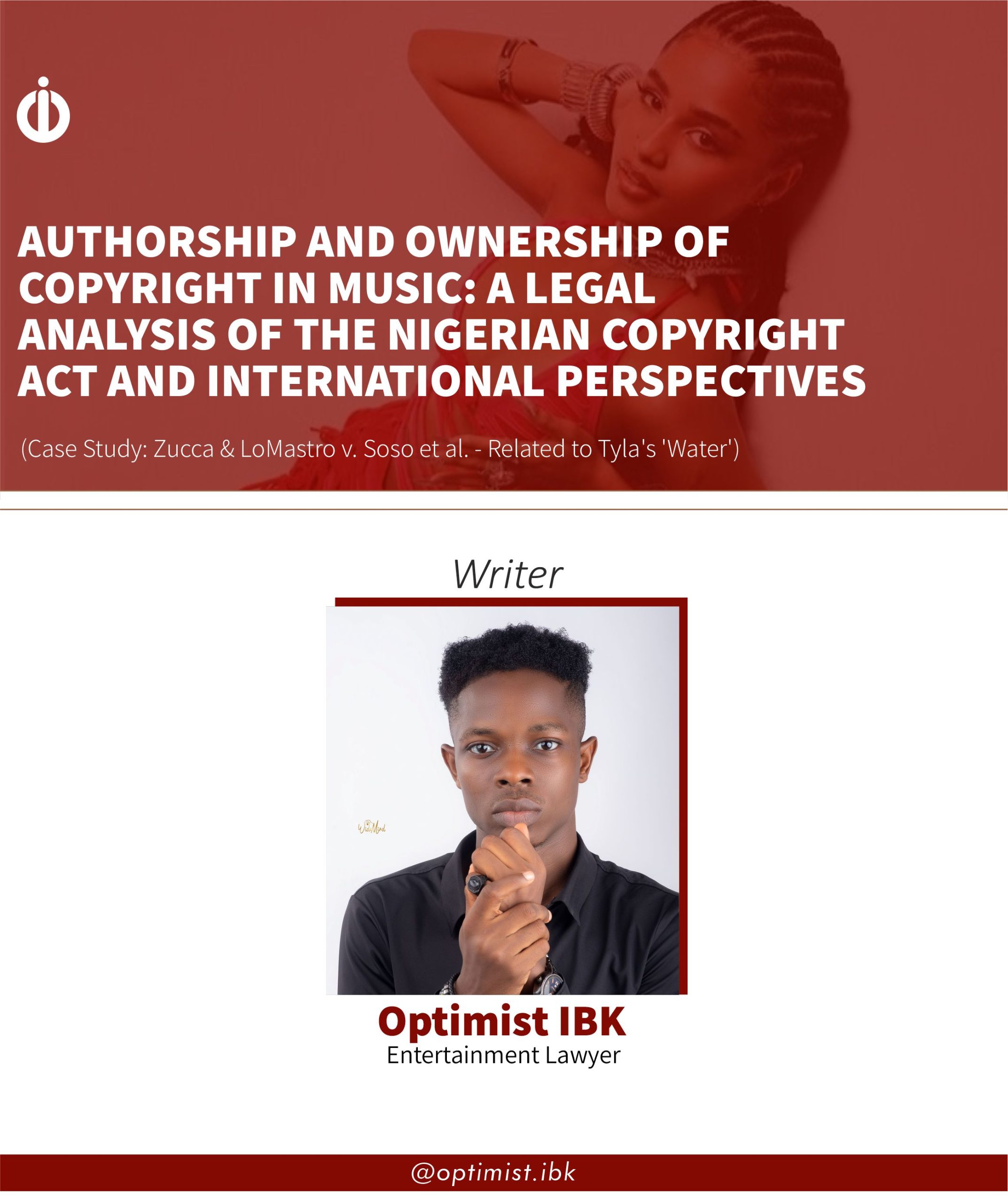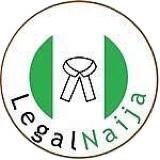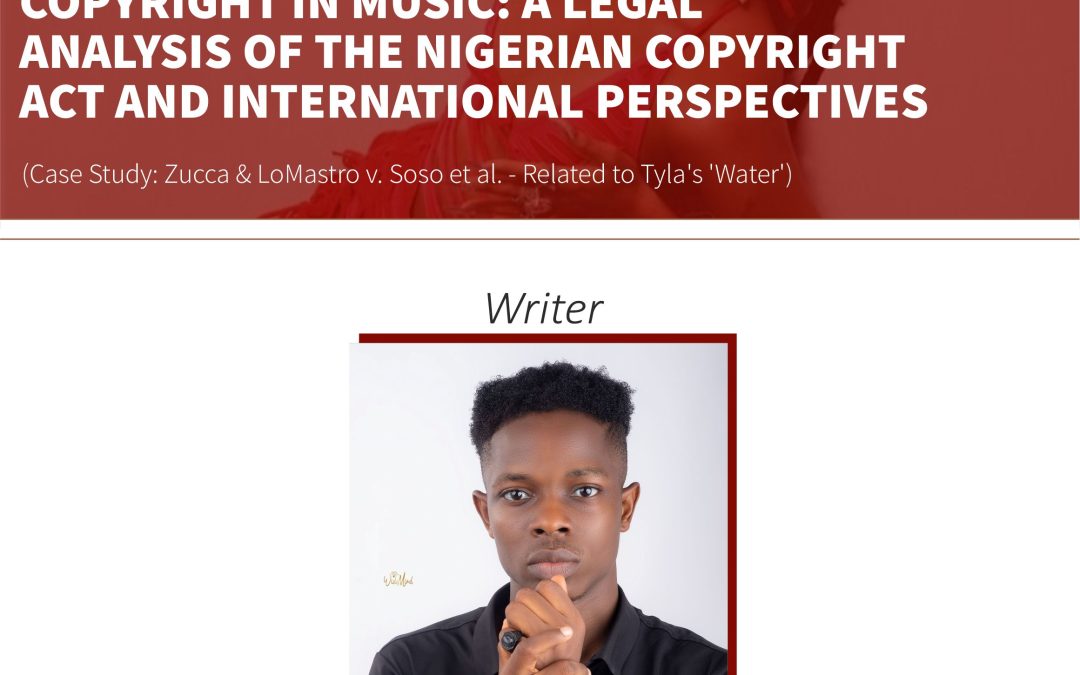
Authorship and Ownership of Copyright in Music: A Legal Analysis of the Nigerian Copyright Act and International Perspectives
(Case Study: Zucca & LoMastro v. Soso et al. – Related to Tyla’s ‘Water’)
Abstract
This article is dedicated to Music Business for Africa and Ivory and Black LP – 2024. As a student of MBA for Africa, we were tasked with drafting a producer agreement, which led to a critical debate on whether copyright in music belongs to the creator or the funder. While many argued for the funder, my academic research and the Copyright Act support the view that the creator owns the copyright unless otherwise agreed. A litigation expert pointed out that since the Nigerian Copyright Act does not expressly resolve this issue, it would be left to the courts to determine ownership.
While preparing this article, I encountered the lawsuit Olmo Zucca & Jackson LoMastro v. Sammy Soso, Tyla Seethal, and Sony Music Entertainment. This lawsuit illustrates the potential for confusion arising from unclear definitions of ‘author’ in copyright law, particularly in a rapidly growing music industry.”
The Nigerian music industry has witnessed exponential growth, with platforms like Spotify reporting a 49% increase in music exports over the past three years and a N58 billion payout to Nigerian artists in 2024 alone[1]. This surge underscores the critical need for clear copyright definitions to protect stakeholders’ rights and foster continued investment. However, ambiguities in the Nigerian Copyright Act, particularly concerning the definition of “author” in musical works and sound recordings, have led to disputes over ownership. The recent U.S. lawsuit involving producers Olmo Zucca and Jackson LoMastro against artist Sammy Soso, fellow artist Tyla Seethal, and Sony Music Entertainment highlights the complexities surrounding authorship and ownership in the music industry.
Introduction
Copyright law serves as the bedrock for protecting creative works, granting creators exclusive rights to reproduce, distribute, and adapt their creations. In the realm of music, two primary components are subject to copyright: the musical composition (encompassing melody, harmony, and lyrics) and the sound recording (the fixed embodiment of a performance). Understanding the delineation of rights between these components is essential for artists, producers, and investors. The Nigerian Copyright Act of 2022 outlines these protections but presents ambiguities, particularly in defining the “author” of a sound recording. This lack of clarity can lead to disputes over ownership, as evidenced by recent international legal battles. This article aims to clarify the complexities surrounding authorship in Nigerian copyright law by comparing international legislative frameworks, including the UK Copyright Act, the U.S. Copyright Act, and the Berne Convention. It also highlights the need for legislative reform to align with global standards and ensure adequate protection for music creators.
Authorship and Ownership in Musical Works
The concept of “authorship” is pivotal in determining copyright ownership. Generally, the author is the individual who translates an idea into a fixed, tangible expression. In musical works, this typically refers to the composer or songwriter who creates the melody and lyrics. According to the Nigerian Copyright Act, the author of a musical work holds the initial copyright, granting them exclusive rights to reproduce, publish, and perform the composition. These rights can be transferred or licensed through formal agreements, allowing for flexibility in commercial exploitation.
Authorship and Ownership in Sound Recordings
Determining authorship in sound recordings is more complex. The Nigerian Copyright Act [2] defines the author of a sound recording as “the person by whom the arrangements for the making of the sound recording were made.” This definition is ambiguous, potentially encompassing producers, record labels, or financiers who oversee the recording process. In practice, ownership of the sound recording, often referred to as “master rights,” typically resides with the producer or the entity that financed the recording, unless otherwise stipulated by contract. This aligns with practices in other jurisdictions, such as the United Kingdom, where the producer is recognized as the author of the sound recording.
Importantly, in musical works, the composition (melody and lyrics) is distinct from the sound recording (the performed and recorded version of the composition). The author of a musical composition is typically the songwriter or composer, while the author of a sound recording is usually the producer or entity responsible for its creation. However, in many cases, artists, producers, and contributors may share ownership of the master recording, unless agreements specify otherwise. This principle is evident in global copyright laws, including the U.S. Copyright Act and the UK Copyright, Designs and Patents Act 1988.
Case Study: Zucca & LoMastro v. Soso et al.
A recent lawsuit filed in the United States District Court for the Central District of California highlights this ongoing battle. Producers Olmo Zucca and Jackson LoMastro have taken legal action against Samuel Awuku (professionally known as Sammy Soso), artist Tyla Seethal, and Sony Music Entertainment, alleging that their contributions to a song recorded in March 2023 were wrongfully diminished.
According to the lawsuit, Zucca and LoMastro were full producers in the session, creating key instrumental elements, yet they were not credited or compensated fairly. Instead, Awuku allegedly took sole producer credit, secured a deal without informing them, and allocated them less than their rightful share of royalties. Despite being listed as co-authors in the song’s copyright registration, they were excluded from negotiations and denied proper recognition.
This case underscores a critical debate in music copyright law: who truly owns a sound recording—the contributors who shape its creative direction or the party who takes control of its commercial release? As the industry grapples with these questions, this lawsuit serves as a timely case study on the intersection of authorship, ownership, and producer rights in modern music production.
International Perspectives on Copyright Authorship
Internationally, copyright laws exhibit variations in defining authorship and ownership:
- United Kingdom (UK) Copyright Act
- UK Copyright[3] – Defines the producer (person arranging for the recording) as the author of the Sound Recording. Authorship of work in relation to a work, means the person who creates it. The person shall be taken to be- in the case of a sound recording, the producer.
- Under UK law, the producer (the person arranging for the recording) is recognized as the author of a sound recording. This is consistent with international conventions such as the Rome Convention and the WIPO Performances and Phonograms Treaty (WPPT).
- United States Copyright Act
- The U.S. Copyright Act[4] defines a sound recording as “a work that results from the fixation of a series of musical, spoken, or other sounds.” However, it does not explicitly define the “author” of a sound recording. Instead, authorship is determined by factors such as:
- Creative control over the recording process
- The role of the producer in shaping the final product
iii. Whether the recording was created as a “work made for hire”
- The U.S. case Community for Creative Non-Violence v. Reid (1989) [1] established that an author is “the person who translates an idea into a fixed, tangible expression entitled to copyright protection.” This definition supports the argument that creators, rather than funders, should hold copyright ownership.
These differences underscore the necessity for clear contractual agreements to delineate rights and prevent disputes.
Other Laws that Influence the Nigerian Copyright Act
The Nigerian Copyright Act 2022 was influenced by international treaties, including:
- Berne Convention (1886, as amended): Recognizes authors’ rights and provides automatic protection.
- WIPO Copyright Treaty (1996): Addresses digital rights and piracy concerns.
- TRIPS Agreement (1994): Sets minimum copyright standards under WTO regulations.
However, despite these influences, the Act lacks clarity on the definition of authorship in sound recordings, leading to misinterpretations and potential legal disputes.
Defining Authorship in Music
- Definition of Sound Recording
- A sound recording refers to a fixation of sounds that can be perceived and reproduced. Under the Nigerian Copyright Act 2022 [2], it is defined as: The fixation of a sequence of sounds capable of being perceived aurally and of being reproduced, but does not include a soundtrack associated with an audiovisual work.”
- Who is the Author of a Sound Recording?
- Authorship can be attributed to different parties, depending on the legal framework:
- Producer: Oversees recording, mixing, and mastering.
- Sound Engineer: If they significantly shape the final output.
iii. Record Label: If it finances and arranges the recording process.
- Independent Artist: If self-producing, they retain authorship.
- The Nigerian Copyright Act follows the UK model, leaning towards the producer as the author. However, this contradicts judicial interpretations in cases like Community for Creative Non-Violence v. Reid, where U.S. courts ruled that the person who fixes an idea in a tangible medium is the author.
Personal Definition of an Author in Copyrighted Work
An author in a copyrighted work is someone who has contributed something that is independently copyrightable. If a person’s work is not copyrightable, that person should not be considered an author. For someone else to claim ownership of a work, not authorship, there must be an agreement that transfers the right from the author to the other person, such as a composer and producer transferring their rights to a record label. I do not consider a financier an author; however, such a person can be the owner of the copyright work but not the author. Just because someone funds a musical work does not make them the author of that musical work.
Judicial Provisions as to Who is an Author
- Nigeria: Oladipo v. African Songs [5]
- Issue: Dispute over authorship and ownership of a musical composition.
- Ruling: The court recognized the songwriter as the copyright owner of the musical work, but the label owned the sound recording rights.
- This case primarily addressed the copyright ownership of musical compositions, not sound recordings. The case focused on the author of the composition (the songwriter/composer) rather than the ownership of the master recording (which is a separate copyrightable element in music). The ruling established that the author of a musical work is the person who created the original composition, which typically includes the songwriter or composer. This aligns with the definition of “author” under Section 51 of the Copyright Act (Cap C28 LFN 2004), which states that the author of a literary, musical, or artistic work is the person who created it.
- U.S.: Community for Creative Non-Violence v. Reid (1989) [6]
- Issue: Whether an independent artist’s work was a “work made for hire.”
- Ruling: The court ruled that the person who fixes an idea in a tangible medium is the author.
- This case is a key U.S. Supreme Court case that clarified the definition of an “author” under U.S. copyright law and the distinction between independent contractors and employees in copyright ownership.
- Key Ruling on “Author”:
- The Court held that the “author” of a work is the person who creates it unless it qualifies as a work made for hire under 17 U.S.C. § 101 of the Copyright Act of 1976.
- In the absence of a “work for hire” agreement, the independent creator (not the hiring party) is the owner of the copyright.
- The case does not specifically discuss sound recordings. However, its principle applies to the music industry.
- UK: Fisher v. Brooker (2009) [7]
- Issue: A musician claimed co-ownership of a song for contributing to the arrangement.
- Ruling: The court ruled that instrumental contributions do not automatically make someone a co-author.
- The case is a landmark UK copyright case concerning joint authorship and ownership rights in musical compositions.
- Key Ruling on “Author”:
The House of Lords ruled that Matthew Fisher, the organist of Procol Harum, was entitled to a share of the copyright in the song “A Whiter Shade of Pale” because his contribution (the organ solo) was significant and original.
The case reaffirmed that an author is the person who creates the original expression in a work under UK copyright law [8].
- The case focused on the musical composition (songwriting) rather than the sound recording. However, its principle applies to disputes over joint authorship in music.
Recommendations for Nigerian Copyright Law
Given the rapid growth of Nigeria’s music industry, it is imperative to address the ambiguities in the Copyright Act regarding authorship of sound recordings. Clarifying the definition of “author” to specify the roles of composers, producers, and financiers can mitigate disputes and foster a more transparent industry. Implementing standardized contractual practices that clearly outline ownership and royalty distributions will further protect stakeholders and encourage investment.
To resolve these issues, Nigeria must:
- Amend the Copyright Act to provide a clear definition of authorship in sound recordings, distinguishing between creators and financiers.
- Adopt contractual best practices from international jurisdictions to define ownership terms.
- Create a Special Tribunal for Entertainment Law for better interpretation of the law.
- Align with WIPO standards to ensure Nigerian music creators receive global recognition and protection.
Conclusion
My definition of an author is what I believe should be obtainable in the music industry, which is supported by some judicial provisions. The Nigerian Law defines the author of a photograph as the person who takes the photograph but fails to clearly state the author of a sound recording as the person who created it. As we continue to create sounds in the industry, I will continually advise that creators should always have a clear agreement between all the contributors of the musical works, and financiers should not regard themselves as the authors of musical works or sound recordings unless there is an agreement that transfers ownership to them. Split sheets and assignment agreements should be signed in musical works to avoid future disputes, as currently happening in the case of Olmo Zucca & Jackson LoMastro v. Sammy Soso, Tyla Seethal, and Sony Music Entertainment.
The burgeoning Nigerian music industry stands at a crossroads where legal clarity can either propel it to greater heights or hinder its progress. The recent lawsuit involving Zucca and LoMastro highlights the potential for disputes arising from ambiguous definitions of authorship and ownership. By refining the Copyright Act to provide clear definitions and encouraging comprehensive contractual agreements, Nigeria can ensure that its artists, producers, and investors operate within a framework that promotes fairness, creativity, and sustained growth.
References
- 2024 Loud & Clear report, by Spotify
- Section 108 (1) (d), Copyright Act 2023
- Section 9 UK Copyright, Designs and Patents Act 1988
- Copyright Act (17 U.S.C. § 101)
- Community for Creative Non-Violence v. Reid, 490 U.S. 730 (1989).
- Oladipo v. African Songs Ltd. (Suit No. LD/1138/73).
- Fisher v. Brooker, [2009] UKHL 41.
- (Copyright, Designs and Patents Act 1988, Section 9(1)

